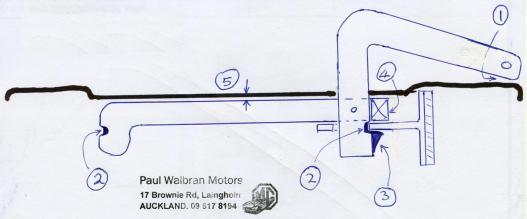Adjustment of rear drum brakes and handbrake
Note: Midgets and late rubber bumper B’s used rods rather than cables in places. In this note, please read handbrake cable to be handbrake rod where relevant.
If the handbrake lever is coming up higher than it should, it’s an definite tell-tale that adjustment is needed. Sometimes the handbrake, and rear brakes in general, seem to run out of adjustment. This is often assumed to be a stretched handbrake cable, but in fact this is quite unusual and the problem is usually incorrect adjustment method or accumulated wear in the rest of the rear brakes.
The correct adjustment sequence is ALWAYS adjust the shoes to the drums before going anywhere near the handbrake cable – if the handbrake cable pre-loads the shoes, correct adjustment and efficient handbrake operation is impossible. Unless you know for sure that it was adjusted correctly last time, you should first disconnect the handbrake cable at the drum on one side so that any pre-load currently being supplied by the cable is eliminated. (It doesn’t matter which, as the equalisation mechanism ensure the cable load is released from the other side too).
Once the shoes are adjusted properly, then adjust the cable to remove any slack but not so far that it causes the shoes to drag. If you find that you run out of cable adjustment at this stage, then possibly the cable has stretched, but it is more likely that wear in the mechanism in the drum is the problem.
To check if drum mechanism wear is present, look at how far out from the backplate the lever, to which the cable attaches, is when it takes up. For optimum geometry, it should rest right back against the backplate and take up within 5mm . If it is, then it is definitely the cable which is at fault and should be replaced. However, on most occasions there is a significant gap there, sometimes approaching half an inch or more. When this happens, braking efficiency – that of the handbrake in particular – will be impaired, as the further out the take-up point gets the less the mechanical advantage transmitted to the shoes.The causes of this are
- wear in the linkages/levers in the drum
- wear in the brake drum itself (very common)
Wear in the drum levers/linkages is easily addressed by welding to build up the base of the notches which engages the shoes and dressing off. (Don’t forget to measure where the old notch’s base was before welding!)
To an extent, this process can also be used to overcome a bit of wear in the drum, but well worn drums should always be replaced – especially Midget ones as I have seen them crack between rim and centre. The max drum oversize should be embossed inside the drum, if not then use +.060″ as a replacement figure.
In the case of the Midget, once the correct take-up situation at the drum is achieved, there are two remaining obstacles in the way of a good handbrake:
The first one is in the positioning of the idler (the bit which transfers the effort from the cable to the two cross rods). At take-up it’s arms should be at about 90 deg to the rods. Once adjusted like this, apply the handbrake as hard as you can and check for binding – if the idler goes too far past 90 deg the rods bottom out in the slots of the idler arms and start to bind. Any further effort goes into trying to bend the rods!.
The second issue in the Midget set-up arises because the leading shoe is not activated directly by the primary lever (the one to which the cross rod is attached), but instead is actuated by the secondary lever – the one which runs across underneath the wheel cylinder to the other (leading) shoe. This secondary lever is dragged onto the backplate by the pull of the cross rod on the primary lever.
The resulting friction between backplate and secondary lever absorbs some of the effort that’s transmitted to the leading shoe – sometimes it can be quite a lot. We have addressed this by deepening and re-shaping the notch in the primary lever which engages with the shoe so that the sideways thrust is then taken by the primary lever hanging on the shoe, in conjunction with grinding the inner edge of the secondary lever to give more clearance from the backplate.
The things you learn from decades of motorkhanas/autotesting where an efficient handbrake is paramount to steer the back end of the car!
Here’s a diagram of the MGB and Midget handbrake mechanism with the relevant points annotated (cool artwork eh?). Note: Does not apply to Mk1 (948cc) Midgets which used a different system , which they shared with the MGA, with the lever mounted in the end of the single-acting wheel cylinder.

References on the diagram are:
- Max gap here at take-up of handbrake about 5mm
- Build up notches to compensate for linkage wear.
- In the case of the Midget, to increase load transmission to the leading shoe, add metal here onto primary lever to provide a firm footing to take the reaction force of the sideways pull on the rod. In doing so, ensure that the built up bit has an approx wedge-shaped gap between it and the shoe (as shown) to allow for the rocking action of the lever as it is actuated. The contact face of the built up bit should have an appropriate radius to allow this rocking action and keep proper contact with the shoe. Note that there is a limit to the amount of build-up possible as the lever still has to fit through the slot in the shoe. An small (~2mm) extension of the slot towards the inner edge of the shoe can usefully be done to allow a correspondingly better bearing surface. Check when finished that it doesn’t jam.
- Cut off this extension of the secondary/transfer lever. It’s presence encourages binding by the scissor-action of the two levers on the shoe. If this happens, much of the handbrake pull goes into clamping the shoe between these two and not on pushing the shoes apart!
- Grind the inside edge of the transfer lever to gain clearance from backplate, thus eliminating frictional drag which reduces the effort transferred to the leading shoe.
Then smile at how much better the handbrake works!!

